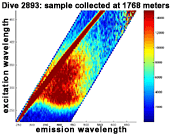 |
Oil and gas seep mapping in
a sediment-covered hydrothermal area: Guaymas Basin
We are testing a new method of oil and gas seepage detection
using fluorescence detection of oil and of bottom pore
fluids shoved upward from sediments by upward moving gas.
Two fluorometers were deployed, a Sea Tech which "sees"
dissolved organic matter (DOM) and a Chelsea Instruments
fluorometer which "sees" oil. Plots are generated of fluorescence
signal versus either water depth or time. These two instruments
were deployed from the unmanned submersible, Jason, during
an April 1998 R/V ATLANTIS research cruise, in the Guaymas
Basin in the Gulf of California. The overall purpose of
the cruise was to study and map hydrothermal vents in
this area. Figures
and tables and a summary of the paper
published by the Marine Technology Society (MTS, Aug 1998)
are available. Results have also been published as a virtual
document.
|
 |
| |
Organic geochemical indicators of dynamic (i.e. present
day) fluid flow in Gulf of Mexico petroleum reservoirs
(with the The Global Basins Research Network, GBRN) This
is a collaborative project with other universities and
oil companies.
Using 4D database software from
ACI, Inc.
our geochemistry databases are available online to authorized colleagues.
Geochemistry Data Server Access(access is password protected) |
 |
| |
Organic characteristics of large (several km) subsurface
pressure chambers or "bottles" which remain out of hydrodynamic
with surrounding sediments over geologic time. Recent
collaborative research with Cornell University has led
to a "Hydrocarbon Plugging Hypothesis" in which phase
changes between gas-oil mixtures caused by changes in
subsurface pressure are proposed as an important plugging
mechanism. In addition, study of porosity versus depth
profiles the US Gulf Coast strongly suggest gas generation
(rather than compaction) to be both a cause of deep overpressures
and an important driving force for oil and gas migration.
Techniques are being developed to merge geochemistry data
from this region with
seismic data that has been interpreted at Cornell.
|
 |
| |
Organic geochemical indicators of dynamic (i.e. present day) fluid
flow in Gulf of Mexico petroleum reservoirs (with the
The Global Basins Research Network, GBRN)
This is a collaborative project with other universities and oil companies. |
 |
| |
Organic geochemical techniques are being applied to sediments,
fluids, and gases collected from the Middle Valley Hydrothermal area
in the eastern pacific about 200 miles west of British Columbia
collected by the Ocean Drilling Project in Summer of 1991 (ODP Leg
139). A paleotemperature scale has been developed using organic
petrographic techniques (i.e. vitrinite reflectance and spore
fluorescent measurements). Changes gases, kerogen, and bitumen are
being compared for various thermal and venting regimes. These
changes are also being compared to those produced in laboratory
heating or hydrous pyrolysis experiments. |
 |
| |
Laboratory hydrous pyrolysis technique using a flexible
reaction
cell which permits samples to be withdrawn at the temperature
and
pressure of an experiment, avoiding ambiguous retrograde
reactions
caused by the sampling process. These experiments also
differ
significantly from previous hydrous pyrolysis experiments
because
pressure is maintained above the two-phase boundary of
water,
ensuring that only liquid water exists in the reaction
cell. In
contrast, hydrous pyrolysis experiments performed in
fixed volume
reaction vessels require that a vapor phase exist above
liquid water.
As a result volatile species such as the low molecular
weight
hydrocarbons partition extensively into the vapor phase
effectively
reducing their chemical interaction with solid reactants,
dissolved
species, and liquid water. |
 |
| |
Gas is mobile and therefore difficult to measure in
the geologic samples. A number of new analytical techniques have been
developed or applied in new ways to this research. |
 |
| |
Baseline studies have been conducted on organic compounds present in Massachusetts
Bay sediments and water column particulates. |
 |
| |
Research in progress includes:
- gas hydrate distribution and influence on the environment
- determination of kinetic parameters of gas generation from
several rocks kerogens
- water as a hydrogen source for gas generation in the presence
of some minerals
- influence of redox on vitrinite reflectance measurements
- reactions of sulfur during hydrous pyrolysis of Monterey shales
|
 |
| |
|